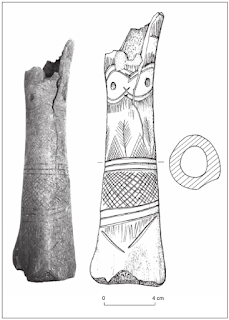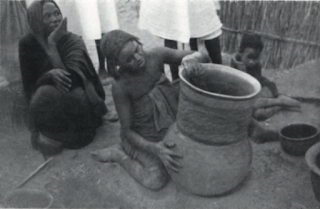Fur women from Sudan making clay pots...Pic from "Sudan Notes and Records Vol. 22, No. 1 (1939)".

And in there we read that Fur people regarded pots, their making and their use, as "female" only and a taboo for men...
For instance, in the above article we can read that when ethnographers asked Fur men how do you say in their language "he lit fire under "burma" (pot used in brewing beer)", the reply was that "you can't say that in our language, cause only women can do that"...
The authors then say that this taboo most likely originates from the ancient association between pots and goddess [mother earth] as for instance "in Nigeria, pots are still associated with mother goddess and a pot is a symbol for a female genitals"...
In "Nile Valley archaeology and Darfur ethnography: the impact of women on cultural evolution. A personal reflection" Randi Haaland gives us further info about this association between pots and women in Fur society:
"The Fur used terms for body parts to describe parts of pots in addition they explicitly associated pots as females, and in particular with motherhood occasionally manifested by placing two protrusions called nansu (breasts) on pots..."
"...Grain storage pots were made by women and only accessed by women...Body terms are used for different parts of the container such as stomach, neck and mouth. And these granary pots are made with features resembling breasts."
It seems that not only pots were exclusively in the female domain. Any grain processing and storing equipment was under strict female control too...Like a cooking fireplace, which is exclusively controlled by a woman. And grinding stones...

"Women in the village were making their own grinding stones. Suitable raw material was found in only one area, where a fine grained sandstone was located. Women had their own quarry where they extracted the raw material and did the rough shaping of the grinders..."

"...The making and using of grindstones were closely associated with female identity, so much so that when grinders are used in male dominated activities like iron production, it is only women who perform the task of grinding the ore."
These taboos are all linked with tools used for storing, grinding, cooking grain. Which indicates that they all come from the grain cult, which directly links woman, mother and female fertility and earth, mother earth and earth fertility...
This is confirmed by this taboo:
"Porridge and beer, both made from the same raw material – millet – are both made by women. In Fur tradition, they were set apart from other food items in the sense that the selling of these products would imply an activity classified as shameful, similar to selling sex."
This elevation of grain, grain food and grain drink to a level of holy food is very interesting...It must be very very old, coming from the time when grain was rare luxury. I believe that this grain cult most likely arrived to Sudan with the Neolithic farmers.
And got preserved in Sudan isolated until present time. We actually find evidence of the existence of such cult in archaeological, historical and ethnographic data throughout Eurasia from Neolithic until present day...
The remnants of this female grain cult were preserved in European "folklore" to this day, particularly among Slavs...I talked about this a lot already, like in this post about the "Mother of grain"...
The symbolic link between women and earth depicted on this Early Vinča Culture terracotta figurine from Jela, Iron Gate region of the Danube, Serbia, c. 5200 BC, H. 5.3 cm, which has a branching plant growing out of the womb...
I have been meaning to talk about the female cult of the bread baking pottery from Serbia for a while, but I always get distracted with something else, so...But I promise I will get to it soon...
PS: I want to thank my friend @dalaygiz for reminding me of this amazing Bronze Age terracotta couple from Tell Marlik in Iran. The man is depicted with a knife and a woman with a...pot...



















